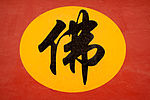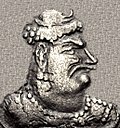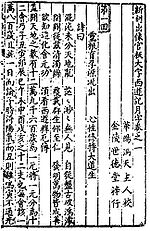Xuanzang (Chinese: 玄奘; Wade–Giles: Hsüen Tsang; [ɕɥɛ̌n.tsâŋ]; 6 April 602 – 5 February 664), born Chen Hui or Chen Yi (陳褘 / 陳禕), also known by his Sanskrit...
84 KB (10,878 words) - 17:37, 25 December 2024
Xuanzang is a 2016 Chinese-Indian historical adventure film that dramatizes the life of Xuanzang (602—664), a Buddhist monk and scholar. The film depicts...
21 KB (2,392 words) - 21:39, 7 November 2024
Tang Sanzang (redirect from Xuanzang (mythology character))
Wu Cheng'en. Tang Sanzang is based on the historical Tang dynasty monk Xuanzang. Tang Sanzang's birth surname name was Chen (陳), but having been found...
13 KB (1,351 words) - 20:56, 7 December 2024
Xuanzang Temple, may refer to: Xuanzang Temple (Nanjing), Buddhist temple in Xuanwu District, Nanjing, Jiangsu, China Xuanzang Temple (Taiwan), Buddhist...
272 bytes (57 words) - 14:51, 23 July 2022
Xuanzang Temple or Syuentzang Temple (Chinese: 玄奘寺; pinyin: Xuánzàng Sì; Wade–Giles: Hsüan2-tsang4) is a Buddhist temple located in the Sun Moon Lake tourist...
7 KB (448 words) - 11:36, 14 October 2023
Xuanzang Temple (Chinese: 玄奘寺; pinyin: Xuánzàng Sì) is a Buddhist temple located within Jiuhua Mountain Park [zh], in Xuanwu District, Nanjing, Jiangsu...
5 KB (320 words) - 04:29, 9 October 2023
Śīlabhadra (section Śīlabhadra and Xuanzang)
teachings, and for being the personal tutor of the Chinese Buddhist monk Xuanzang. Śīlabhadra was said to have originally been from Magadha. Although another...
8 KB (975 words) - 10:45, 7 November 2024
than Xuanzang's claims or the Nalanda site was many times larger than numerous excavations have so far discovered and what Xuanzang describes. Xuanzang travelled...
113 KB (12,691 words) - 04:15, 18 January 2025
artists and religious visitors from far and wide. The Chinese traveller Xuanzang visited the imperial court of Harsha and wrote a very favourable account...
26 KB (2,612 words) - 06:14, 9 January 2025
version as translated by Xuanzang is the most popular version of adherents practicing East Asian schools of Buddhism. Xuanzang's canonical text (T. 251)...
98 KB (11,367 words) - 09:40, 21 October 2024
the Chinese traveler Xuanzang (Hiuen Tsang) possibly contain a reference to an ancient version of this fair in 644 CE. Xuanzang mentions that Emperor...
38 KB (4,622 words) - 17:31, 19 January 2025
East Asian Yogācāra (section Xuanzang's school)
Bodhiruci, Ratnamati, Huiguang, Paramārtha, Jingying Huiyuan, Zhiyan, Xuanzang and his students Kuiji, Woncheuk and Dōshō. The East Asian consciousness...
49 KB (6,020 words) - 13:15, 13 December 2024
disciple of Xuanzang, spent more than one year editing the book through Xuanzang's dictation. The text presents an account of Xuanzang's route with religious...
10 KB (1,180 words) - 23:21, 8 November 2024
Mihirakula (section Xuanzang)
the 7th-century travelogue of the Chinese Buddhist pilgrim and student Xuanzang, Mihirakula ruled several hundreds of years before his visit, was initially...
25 KB (2,905 words) - 12:40, 19 January 2025
fictionalized and fantastic account of the pilgrimage of the Chinese Buddhist monk Xuanzang, who journeyed to India in the 7th century AD to seek out and collect Buddhist...
50 KB (6,531 words) - 23:11, 20 January 2025
Bhāvaviveka Dharmakīrti Candrakīrti Zhiyi Bodhidharma Huineng Shandao Xuanzang Fazang Amoghavajra Saichō Kūkai Shāntideva Shāntarakshita Wohnyo Mazu Daoyi...
199 KB (23,221 words) - 17:45, 17 January 2025
and probably the successor of Budhagupta. According to the Chinese monk Xuanzang, Narasimhagupta had to pay tribute to the Huna king Mihirakula. Finally...
6 KB (505 words) - 10:40, 7 November 2024
Pulakeshin II (section Xuanzang's visit)
Chalukyan territories to the south is attested by the Chinese pilgrim Xuanzang. In the east, Pulakeshin subjugated the rulers of Dakshina Kosala and Kalinga...
54 KB (6,728 words) - 14:03, 20 January 2025
According to the text, Xuanzang spilled his surplus of water while in the deserts near Dunhuang. After several days without liquid, Xuanzang had a dream where...
12 KB (1,640 words) - 05:33, 28 December 2024
understanding of Yogācāra. The Triṃśikā was translated into Chinese by Xuanzang in 648 CE at Hongfu Monastery. It was also translated into Tibetan in antiquity...
4 KB (505 words) - 21:44, 17 January 2025
Consciousness-only). The CWSL was written by the early Tang dynasty monk Xuanzang (602–664), who drew on numerous Indian Yogacara sources and scholars as...
10 KB (1,145 words) - 07:25, 29 December 2024
Bhaskaravarman (section Xuanzang's account)
Thaneswar, against the alliance of the Gauda and East Malwa. He was visited by Xuanzang and Wang Xuance, the envoys of the Tang dynasty who have left accounts...
15 KB (1,848 words) - 12:32, 9 January 2025
Indian king mentioned in the writings of the Chinese traveler Xuanzang (Hieun Tsang). Xuanzang mentions him in Fascicle V of Dà Táng Xīyù Jì (Great Tang Records...
6 KB (625 words) - 04:30, 8 January 2025
methods there and then invented his methods. The 7th-century traveller Xuanzang claims to have seen a pillar marking the site of Ashoka's "Hell". The Mahavamsa...
140 KB (16,433 words) - 12:37, 14 January 2025
not lay. By this time, Chinese pilgrims, such as Faxian (337–422 CE), Xuanzang (602–664), Yijing (635–713 CE) were traveling to India, and their writings...
151 KB (17,767 words) - 13:40, 20 January 2025
Buddhapālita Dignāga Bodhidharma Zhiyi Emperor Wen of Sui Songtsen Gampo Xuanzang Shandao Padmasambhava Saraha Atiśa Naropa Karmapa Hōnen Shinran Dōgen Nichiren...
252 KB (28,035 words) - 20:11, 18 January 2025
devotees, such as Xuanzang (7th century), Kuiji, Wonhyo, and Yijing, had the intention of being reborn there after their death. Xuanzang was a famous devotee...
76 KB (8,327 words) - 15:39, 14 January 2025
Buddhapālita Dignāga Bodhidharma Zhiyi Emperor Wen of Sui Songtsen Gampo Xuanzang Shandao Padmasambhava Saraha Atiśa Naropa Karmapa Hōnen Shinran Dōgen Nichiren...
168 KB (17,337 words) - 15:44, 17 January 2025
translator Xuánzàng (玄奘, 602-664) is known for his translation of a massive Sanskrit collection of Prajñāpāramitā sutras called "the Xuánzàng Prajñāpāramitā...
61 KB (6,354 words) - 21:17, 17 January 2025
India. Pushpagiri was mentioned in the writings of the Chinese traveller Xuanzang (c. 602 – c. 664) and some other ancient sources. Until the 1990s, it was...
18 KB (1,562 words) - 13:45, 22 November 2024























